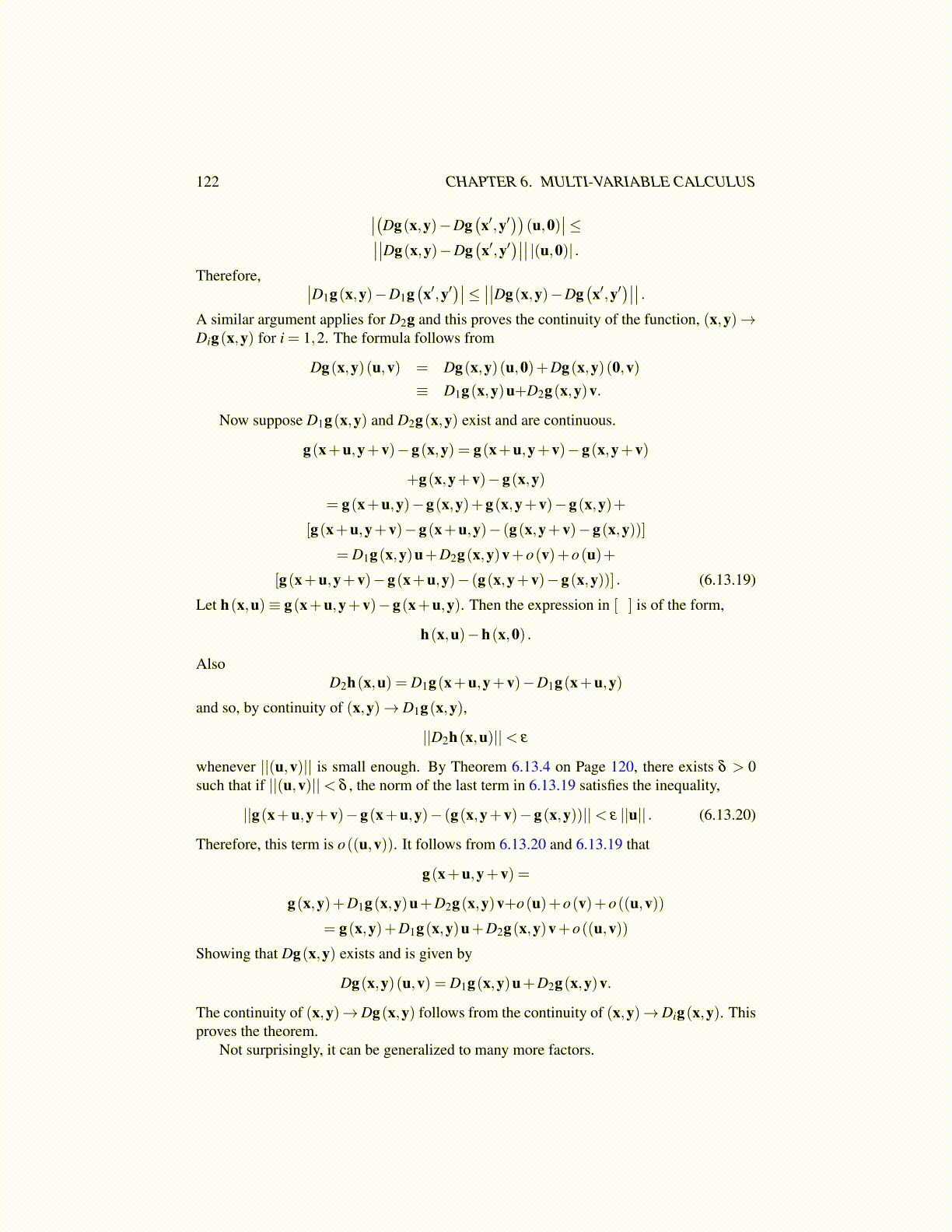122 CHAPTER 6. MULTI-VARIABLE CALCULUS
∣∣(Dg(x,y)−Dg(x′,y′
))(u,0)
∣∣≤∣∣∣∣Dg(x,y)−Dg(x′,y′
)∣∣∣∣ |(u,0)| .Therefore, ∣∣D1g(x,y)−D1g
(x′,y′
)∣∣≤ ∣∣∣∣Dg(x,y)−Dg(x′,y′
)∣∣∣∣ .A similar argument applies for D2g and this proves the continuity of the function, (x,y)→Dig(x,y) for i = 1,2. The formula follows from
Dg(x,y)(u,v) = Dg(x,y)(u,0)+Dg(x,y)(0,v)≡ D1g(x,y)u+D2g(x,y)v.
Now suppose D1g(x,y) and D2g(x,y) exist and are continuous.
g(x+u,y+v)−g(x,y) = g(x+u,y+v)−g(x,y+v)
+g(x,y+v)−g(x,y)= g(x+u,y)−g(x,y)+g(x,y+v)−g(x,y)+
[g(x+u,y+v)−g(x+u,y)− (g(x,y+v)−g(x,y))]= D1g(x,y)u+D2g(x,y)v+o(v)+o(u)+
[g(x+u,y+v)−g(x+u,y)− (g(x,y+v)−g(x,y))] . (6.13.19)
Let h(x,u)≡ g(x+u,y+v)−g(x+u,y). Then the expression in [ ] is of the form,
h(x,u)−h(x,0) .
AlsoD2h(x,u) = D1g(x+u,y+v)−D1g(x+u,y)
and so, by continuity of (x,y)→ D1g(x,y),
||D2h(x,u)||< ε
whenever ||(u,v)|| is small enough. By Theorem 6.13.4 on Page 120, there exists δ > 0such that if ||(u,v)||< δ , the norm of the last term in 6.13.19 satisfies the inequality,
||g(x+u,y+v)−g(x+u,y)− (g(x,y+v)−g(x,y))||< ε ||u|| . (6.13.20)
Therefore, this term is o((u,v)). It follows from 6.13.20 and 6.13.19 that
g(x+u,y+v) =
g(x,y)+D1g(x,y)u+D2g(x,y)v+o(u)+o(v)+o((u,v))= g(x,y)+D1g(x,y)u+D2g(x,y)v+o((u,v))
Showing that Dg(x,y) exists and is given by
Dg(x,y)(u,v) = D1g(x,y)u+D2g(x,y)v.
The continuity of (x,y)→Dg(x,y) follows from the continuity of (x,y)→Dig(x,y). Thisproves the theorem.
Not surprisingly, it can be generalized to many more factors.
122 CHAPTER 6. MULTI-VARIABLE CALCULUS| (Dg (x,y) — Dg (x’,y’)) (u,0)| <||Dg (x,y) — Dg (x’,y’) || |(u,0)|.Therefore,|Dig (x,y) — Dig (x’,y’)| < ||Dg (x,y) — Dg (x’,y’) ||.A similar argument applies for D2g and this proves the continuity of the function, (x,y) >Dig (x,y) for i= 1,2. The formula follows fromDg(x,y)(u,v) = Dg(x,y)(u,0) + Dg (x,y) (0,v)= Dig(x,y)ut+Dog(x,y)v.Now suppose D;g (x,y) and Dog (x,y) exist and are continuous.g(x+u.y+v)—g(x%y) =s(xt+uy+v)—g(xytv)+8 (x,y +v) —g(x,y)=g(x+u,y)—g(x,y)+8(x,y+v)—g(x,y)+[g(x+u,y+v) —g(x+u,y) _ (g(x,y+Vv) —g(x,y))]= Dig(x,y)u+ Dog (x,y) v+o0(v) +o(u) +[g(x+u,y+v)—g(x+u,y) —(g(x,y+v) —g(x,y))]. (6.13.19)Let h(x,u) = g(x+u,y+v)—g(x+u,y). Then the expression in [ | is of the form,h(x,u) —h(x,0).AlsoDoh (x,u) = Dig(x+u,y+v) —Dig(x+u,y)and so, by continuity of (x,y) > Dig(x,y),||D2h(x,u)|| <<whenever ||(u,v)|| is small enough. By Theorem 6.13.4 on Page 120, there exists 6 > 0such that if ||(u,v)|| < 6, the norm of the last term in 6.13.19 satisfies the inequality,IIg(x+u,y+v) —g(x+u,y) —(g(x,y+v) —g(x,y))|| < €|lull. (6.13.20)Therefore, this term is o((u,v)). It follows from 6.13.20 and 6.13.19 thatg(xtu,y+yv) =g(x,y) + Dig(x,y)u+ Dog (x,y) v+0(u) +0(v) +0((u,v))= (x,y) + Dig(x,y)u+Dog (x,y) v+0((u,v))Showing that Dg (x,y) exists and is given byDg (x,y) (u,v) = Dig (x,y) u+ D2g (x,y) v.The continuity of (x,y) + Dg (x,y) follows from the continuity of (x,y) > Djg (x,y). Thisproves the theorem.Not surprisingly, it can be generalized to many more factors.
